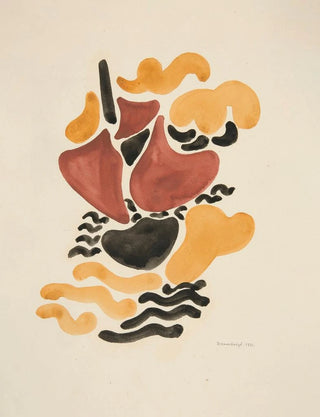Art print Abstraction based on floral shapes IV - David Kakabadze | Art print


View from behind

Frame (optional)
In the vibrant universe of modern art, some works stand out for their ability to transcend time and evoke deep emotions. "Art print based on floral forms IV" by David Kakabadze is one of those creations that, through its apparent simplicity, invites introspective contemplation. This piece, which sits at the crossroads between abstraction and figuration, manages to capture the very essence of nature while freeing itself from the constraints of realism. Through this art print, the viewer is invited on a sensory journey where floral forms metamorphose into a dance of colors and lines, revealing the intrinsic beauty of the world around us.
Style and uniqueness of the work
Kakabadze, master of abstraction, uses organic shapes to create a visual harmony that intrigues and fascinates. The gentle curves and splashes of color in "Art print based on floral forms IV" evoke subtle sensuality, while offering a reflection on the duality between nature and art. The piece consists of delicate hues that overlap and intertwine, seeming to vibrate under the effect of an inner light. This dialogue between the elements of the composition gives rise to a dynamic that captures the eye and stimulates the mind. Moving away from conventional representations, Kakabadze offers a unique vision, where each form becomes a metaphor for life and its blossoming, while fitting into a universal visual language.
The artist and his influence
David Kakabadze, an emblematic figure of Georgian art, knew how to mark his era with an innovative approach to painting. Educated within a rigorous artistic tradition, he quickly freed himself from norms to explore uncharted territories. Inspired by European avant-garde movements, Kakabadze managed to incorporate elements of cubism and fauvism into his work, while maintaining a sensitivity unique to his culture. His commitment to art and his desire to capture the essence of nature make him a pioneer whose influence still endures today. Through his creations,

Matte finish

View from behind

Frame (optional)
In the vibrant universe of modern art, some works stand out for their ability to transcend time and evoke deep emotions. "Art print based on floral forms IV" by David Kakabadze is one of those creations that, through its apparent simplicity, invites introspective contemplation. This piece, which sits at the crossroads between abstraction and figuration, manages to capture the very essence of nature while freeing itself from the constraints of realism. Through this art print, the viewer is invited on a sensory journey where floral forms metamorphose into a dance of colors and lines, revealing the intrinsic beauty of the world around us.
Style and uniqueness of the work
Kakabadze, master of abstraction, uses organic shapes to create a visual harmony that intrigues and fascinates. The gentle curves and splashes of color in "Art print based on floral forms IV" evoke subtle sensuality, while offering a reflection on the duality between nature and art. The piece consists of delicate hues that overlap and intertwine, seeming to vibrate under the effect of an inner light. This dialogue between the elements of the composition gives rise to a dynamic that captures the eye and stimulates the mind. Moving away from conventional representations, Kakabadze offers a unique vision, where each form becomes a metaphor for life and its blossoming, while fitting into a universal visual language.
The artist and his influence
David Kakabadze, an emblematic figure of Georgian art, knew how to mark his era with an innovative approach to painting. Educated within a rigorous artistic tradition, he quickly freed himself from norms to explore uncharted territories. Inspired by European avant-garde movements, Kakabadze managed to incorporate elements of cubism and fauvism into his work, while maintaining a sensitivity unique to his culture. His commitment to art and his desire to capture the essence of nature make him a pioneer whose influence still endures today. Through his creations,
12,34 €






